THE KINGDOM OF DENMARK

A modern Christian Constitutional and Democratic Monarchy located in the Scandinavian region of Europe
This book, commissioned by the Vatican for foreign clergy in Denmark, is written, produced and printed as a service to
the Order of the
Missionaries of Charity by
anthropologist Bent Lorentzen,
Danish American Newmedia Enterprise of Copenhagen, Denmark. The author gives the reader the right to use, copy, and in any way distribute all content found in this book, so long as appropriate referencing credit is included.
Please be aware that this book is in places, biased, in terms of a religion's historic impact on society's and individual people's natural evolution, per say... since even impacts are part and parcel to evolutionary theory.
This book was commissioned to help foreign clergy coming to Denmark to serve the poorest and most vulnerable of its residents, through Mother Therese's generally selfless and helpful ministry... mostly to feed the hungry and comfort the sick.
Therefore, the author decided it was appropriate to conform to a degree of the strictures of a particular religion in this one case, rather than have the book written by someone who would fail to transmit even a trace of the factual cultural history of Denmark.
Please note that the grammar and word-use found in this book are specifically designed for people who learned English as a second language.
PRINTED IN DENMARK, © 2004, Bent Lorentzen
For printed copies of this book, kindy contact Missionaries of Charity, 54A, A.J.C. Bose Road, Kolkata 700 016, India, Phone: 033- 245 2277, 249 7115;
or in Denmark:
Søster Mary Fatima, Kærlighedens Missionærer, Sigurdsgade 29,. 2200 København N., Tlf: (45) 35 85 29 65.
Photos courtesy of Bent Lorentzen, Mediamundo, Danish government, Danish Catholic
Church and Danish American Newmedia Enterprise
at www.denmark.gqnu.net
TABLE OF CONTENTS
HISTORY
CULTURE
EDUCATION
INDUSTRY & AGRICULTURE
AND ECONOMY
RELIGION AND SPIRITUALITY
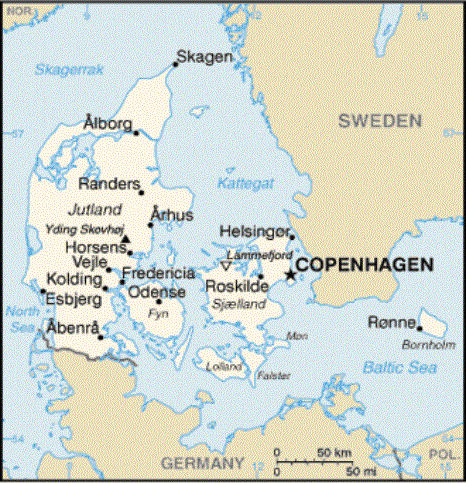
INTRODUCTION
If you don’t include the world’s largest and frozen island -- Greenland -- and the distant Faeroe Islands, Denmark (Danmark in Danish) is a very small, modern and wealthy
Christian country located at the most northern point of continental Europe. This book will mostly be about the peninsula of Jutland, which “sticks” out of
Germany into the North Sea of the Atlantic Ocean and the major islands east of this peninsula near Sweden and into the Baltic Sea, because that’s where most people live. Only a little over 5 million people
live in Denmark. Denmark only shares a 68-kilometer border with Germany. The rest is surrounded by water, which is why Denmark’s history is full of Viking sea explorers.
Denmark’s capitol, Copenhagen (København in Danish), sits at the east coast of the island of Sjælland (Zealand), and because of a very new bridge and tunnel system, it takes only half an hour by
train or car to go to Sweden. One-fourth (1/4) of all Danish people live in this city, often called The Paris of the North. Other major cities are Odense (where fairy tale writer Hans Christian Andersen was born), Århus and Ålborg.
 The world’s 2nd longest suspension bridge between Denmark and Sweden
The world’s 2nd longest suspension bridge between Denmark and Sweden
 It is an ancient country, with Europe’s oldest flag (a Catholic symbol from battle of a thousand years ago) and also has Europe’s oldest capitol city. Although
Denmark’s queen (Margrethe II) is one of Europe’s youngest monarchs, she has Europe’s oldest great-grandfather –
33 generations: King Sigurd Orm i Øje (literally: Worm in His Eye), who ruled one thousand and two hundred years ago.
It is an ancient country, with Europe’s oldest flag (a Catholic symbol from battle of a thousand years ago) and also has Europe’s oldest capitol city. Although
Denmark’s queen (Margrethe II) is one of Europe’s youngest monarchs, she has Europe’s oldest great-grandfather –
33 generations: King Sigurd Orm i Øje (literally: Worm in His Eye), who ruled one thousand and two hundred years ago.
A very interesting fact about Denmark is that even though it’s found so far north (on the 57th Latitude North), the climate is not at all like other places in the world so close to the Polar Regions. On the world map, Denmark is about where you find the frozen Hudson Bay of north Canada and southern Siberia of Russia, where snow can be many meters deep and temperatures can average (minus)
–30 degrees Celsius in the winter. Denmark only has a few weeks of freezing weather each year where only a few centimeters of snow falls, and it melts almost as
quickly as it falls. This is because of a warm ocean current (a sort of river within the ocean) that crosses completely across the Atlantic Ocean from the Gulf of
Mexico in Central America, and brings warm, moist and often turbulent air to the country.
Since Denmark is a Scandinavian country, many people believe that it is full of tall mountains and rocky glacial fjords like its closest friends, Norway and Sweden, but actually the kingdom is very flat,
with the highest point only 173 meters tall.
Although Danish is the common language, most people born after World War II speak enough English to get by with, and it is now taught as a second language in all the schools. Danish is not an easy language to learn because it has special vowel sounds that are difficult to pronounce for people used to English, and that’s why there are three extra letters in the
Danish alphabet (
Å, Æ and Ø). Danes sometimes harmlessly play a joke on English-speaking people by asking them to say tongue twisters, like “Rød grød med fløde” a Christmas
desert that only a Dane could ever pronounce.
The people of Denmark are known for their Christian kindness, gentleness, and have one of the world’s most advanced welfare system where everyone can get free medical help and
education. That’s why people here pay about ½ (half) of what they earn in taxes.
Because Denmark is so small and wealthy it is hard for foreigners to believe that there are so many people who do not have enough food, are homeless and live in the streets, are
so depressed and lonely that there is a very high suicide rate and other social difficulties. This is why spiritual people who serve are very important to this
country.
The history of Denmark goes back to the Stone Age nearly 12 thousand years ago. In the National Museum of Denmark, one can find flint (stone) weapons and
everyday tools crafted by these ancient people who hunted, gathered food from the forests, did a little primitive farming, and lived in prehistoric huts in tiny family villages.
People rarely lived more than 50 years of age. Because of the harsh climate of that time, they believed in nature spirits as a religion, and buried their dead
under a pile of stones, called Cairns.
Here is an example of a Danish Stone Age burial Cairn on the island of Langeland
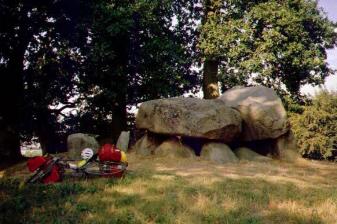
At around 1,500 BC the 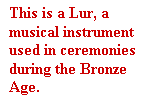 Bronze Age came to Denmark. There are many peat
Bronze Age came to Denmark. There are many peat
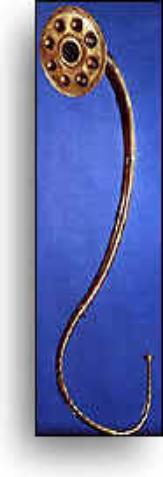 bogs (a type of swamp) in Denmark and because of the natural chemicals found in these swamps, many old things and even bodies from long ago have stayed
preserved.
bogs (a type of swamp) in Denmark and because of the natural chemicals found in these swamps, many old things and even bodies from long ago have stayed
preserved.
The Iron Age began in Denmark at about 500 BC, and because of that metal’s strength, farming became more common. At the same time,
these ancient Danes (Norse) learned weapon making with this metal as well as shipbuilding later on, and that’s how the violent Viking warriors everyone reads about began to battle other cultures.
It is these very special ships, called Vikingeskib (Viking ship) also known as Dragon Ships, which made Denmark become for a short period in the Middle Ages the most powerful
European kingdom.
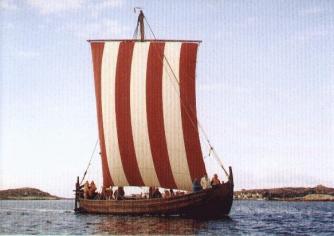 Replica of a Dragon Ship, similar to the ones used to discover America 500 years before Christopher Columbus
Replica of a Dragon Ship, similar to the ones used to discover America 500 years before Christopher Columbus
In the Tenth Century AD, Denmark grew powerful enough to conquer even England. The picture many have of fierce Vikings with horned helmets is partly false, mostly because of movies made in Hollywood. Yes, the Vikings were
merciless because many believed they would go to a special Pagan heaven (Valhalla) if they died in battle. But their armor resembled what other armies of that time
also used.
Denmark became an organized kingdom with King Gorm the Old, who died in 940 AD. His son, King Harald Bluetooth, built a monument over his father’s gravesite
in the small village of Jelling, that said: “I have united all of Denmark and made Danes Christian.” The Benedictines and other priests had come to Denmark in
small groups to convert them, and at first the Vikings tortured and sent them away, but when the king partially accepted Catholicism, Denmark slowly became less pagan. It
was not an easy process, and many rich landowners and warrior lords fought to become King and return Denmark to its pagan beliefs.
Bishop Absalon founded Denmark’s capitol, Copenhagen, nearly 900 years ago by building a fortress near a gathering of fishing houses.
Copenhagen then became a world trade center, which is what Bishop Absalon called the fort (København literally means
Th
e Port of trade).
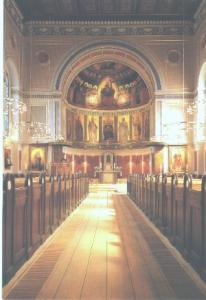 It was Saint Ansgar, a Benedictine Monk (also known as the Nordic Apostle), who finally combined all the small Catholic movements in Denmark into
one church, with King Knud the Great at the time of the Conquest of England. The modern center of the Danish Catholic faith sits at the church in
It was Saint Ansgar, a Benedictine Monk (also known as the Nordic Apostle), who finally combined all the small Catholic movements in Denmark into
one church, with King Knud the Great at the time of the Conquest of England. The modern center of the Danish Catholic faith sits at the church in his memory, St. Ansgar’s Cathedral, in downtown Copenhagen.
his memory, St. Ansgar’s Cathedral, in downtown Copenhagen.
Along with a Christian belief system, Catholicism brought to Denmark modern ideas in farming, trade, craftsmanship, architecture, mathematics, science, and the
common language of the time:
Latin.
Denmark’s first canonized saint is Saint Knud Lavard, a duke married to a Russian countess. In 1131
AD, he asked his cousin and King Niels son, Magnus, to go on a pilgrimage to Jerusalem with him. 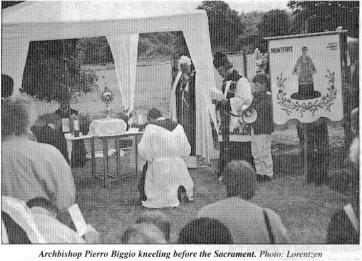 Magnus was very jealous that the common Danish people loved Duke Knud Lavard (many wanted him to become king after King Niels’ death).
Knud had studi
Magnus was very jealous that the common Danish people loved Duke Knud Lavard (many wanted him to become king after King Niels’ death).
Knud had studi ed at a monastery in Germany and preached compassion and kindness to those in power who still believed in cruel Viking justice. For example, if a
man committed a murder, he could offer his son to be executed in his stead. He also served the poor and sick. When Knud
Lavard met with Prince Magnus in the forest by a farming village (Haraldsted) to make plans for the pilgrimage, Magnus had several soldiers waiting behind the trees. These soldiers attacked the defenseless Duke before anyone could protect him. Lavard’s close friends brought his dying body to a field where
after his death, a mystical spring suddenly bubbled up by where his blood had flowed. Sick people who later touched the water were miraculously cured. This spring has now disappeared. Every
year, in July, the Danish Catholic Church holds its largest pilgrimage to Saint Lavard’s place of martyrdom.
ed at a monastery in Germany and preached compassion and kindness to those in power who still believed in cruel Viking justice. For example, if a
man committed a murder, he could offer his son to be executed in his stead. He also served the poor and sick. When Knud
Lavard met with Prince Magnus in the forest by a farming village (Haraldsted) to make plans for the pilgrimage, Magnus had several soldiers waiting behind the trees. These soldiers attacked the defenseless Duke before anyone could protect him. Lavard’s close friends brought his dying body to a field where
after his death, a mystical spring suddenly bubbled up by where his blood had flowed. Sick people who later touched the water were miraculously cured. This spring has now disappeared. Every
year, in July, the Danish Catholic Church holds its largest pilgrimage to Saint Lavard’s place of martyrdom.
Due to his martyrdom, Denmark had a civil war, where both King Niels and his son, Prince Magnus, were killed and Duke Lavard’s son from his Russian Countess
wife became King. This son became one of Denmark’s most beloved rulers, King Vlademar The Great. In 1169 Pope
Alexander III canonized Lavard as Denmark’s first saint.
Women were not allowed to rule Denmark until a law in 1953. But in 1387, the first Queen Margrethe ruled without
the title of Monarch because her son, the Crown Prince, was only a child. What is amazing about her “invisible” rule is that she managed to unite Norway, Sweden
and Denmark into one huge kingdom. This is why one of the national symbols for Denmark is
The Three Crowns of the Kalmar Union.
The next famous ruler of Denmark was King Christian IV, also known as the Builder King (1588-1648). He came to
power shortly after the Lutheran Reformation of 1536 caused most of the Catholic
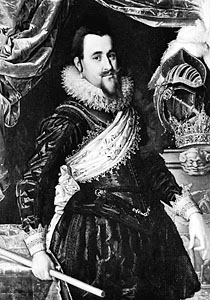 churches and monasteries in Denmark to be burned down, the Catholic faith made illegal, and the Lutheran Church became the official Danish Church,
now called Folkekirken (The State Church). This is the reason why today only one-half of one percent (32 thousand out of more than 5 million) Danish
churches and monasteries in Denmark to be burned down, the Catholic faith made illegal, and the Lutheran Church became the official Danish Church,
now called Folkekirken (The State Church). This is the reason why today only one-half of one percent (32 thousand out of more than 5 million) Danish
 people are Catholic.
people are Catholic.
King Christian IV, who was also king of Norway, tried twice to conquer Sweden but failed and also caused a disaster by entering the horrible “30 Years War”
of all Europe. Between the wars, he worked hard to make Denmark very beautiful and attractive by rebuilding most of downtown Copenhagen and built castles all over
the country. He also founded Oslo, capitol of Norway. He kept most of his attention on big ideas but mostly ignored the every day problems within the kingdom, and therefore many noble people in Denmark grew to not like him while he was alive. After he died in 1648, he was given the credit of making Denmark a proud and beautiful kingdom. He wrote over 3,000 very creative letters about his love for God and how to brew good beer.
The next important monarch in Denmark was King Frederik VII, who understood that in modern times the people should have more control in how they are governed
– or risk a revolution. In 1849 he signed the first Danish Constitution, which made Denmark democratic. Like most democracies of the time, the right to vote was given only to the wealthy. Denmark was actually the second country in the world that gave
women the right to vote in 1915.
In the centuries between Builder-King Christian IV and the First World War, Denmark lost more and more land. One
time a huge kingdom that included Norway, Sweden, England, and parts of France and Germany (and many other regions around the world, including tropical islands,) Denmark became a tiny finger and some islands
north of Germany. In 1650 Sweden invaded Denmark and for a short while occupied it. In an 1864 war with Prussia and Austria, Denmark lost northern Germany.
On April 9, 1940, Nazi Germany invaded Denmark and overnight occupied the whole kingdom, and from there they fought and seized parts of Norway.
Denmark only briefly resisted Germany but gave up under the condition that Denmark partly keep the right to rule itself. That included an agreement with
Hitler that the Danish Jewish people not be deported to concentration camps. For a few years there was an uneasy peace between the German occupiers and the Danish
government. King Christian X often rode his horse through downtown Copenhagen during those years without guards. When
asked by a German general to accept a Nazi guard, the king said, “No.” A poem about his courage says: “For the
 King of Denmark, the heart stands guard.”
King of Denmark, the heart stands guard.”
 His bravery grew legendary. In one legend, after Hitler broke his promise not to touch the Danish Jews in 1943, King Christian X put
the Star of David symbol on his jacket as he rode his horse. The yellow star was something the Nazis required all Jews to wear to identify them. In another story, the King on his horseback approached a government building where the Nazi flag was flying and ordered the German soldier to take it down and put up the Danish flag. The soldier said he would shoot the man that took down the German flag. King Christian then said, “I will be that man.”
The story says that the German soldier took down the Nazi flag and raised the Danish flag. Most of these stories are not actually true, but they describe the
true spirit of the King.
His bravery grew legendary. In one legend, after Hitler broke his promise not to touch the Danish Jews in 1943, King Christian X put
the Star of David symbol on his jacket as he rode his horse. The yellow star was something the Nazis required all Jews to wear to identify them. In another story, the King on his horseback approached a government building where the Nazi flag was flying and ordered the German soldier to take it down and put up the Danish flag. The soldier said he would shoot the man that took down the German flag. King Christian then said, “I will be that man.”
The story says that the German soldier took down the Nazi flag and raised the Danish flag. Most of these stories are not actually true, but they describe the
true spirit of the King.
Almost 8,000 Jews were secretly sent by Danish fishing boats to neutral Sweden to avoid being captured. Thus less
than 500 Danish Jews were captured, and only a few dozen actually died in concentration camps by the end of the war in 1945. This is rather remarkable when perhaps
up to 6 million Jews were killed in these camps during the war.
 After the Second World War, Denmark helped found the United Nations and the North Atlantic Treaty Organization (NATO), a military alliance between
the United Sta
After the Second World War, Denmark helped found the United Nations and the North Atlantic Treaty Organization (NATO), a military alliance between
the United Sta tes and Canada with Western Europe. NATO became the way the “Western World” fought the Cold War
against Communism until Russia became democratic in 1989.
tes and Canada with Western Europe. NATO became the way the “Western World” fought the Cold War
against Communism until Russia became democratic in 1989.
In 1972, when her father King Frederik IX died, Princess Margrethe became the second woman ever to become queen of Denmark. The
first Queen Margrethe was not actually the official queen because the law at the time did not allow a female to become the ruler, but she ruled anyway because her son was much too young.
In 1953 Denmark changed the law.
Queen Margrethe II is married to a French Count and vineyard owner, Prince Henrik, and they have two sons, Crown Prince Frederik (the next king) and Prince
Joachim. She studied archeology and philosophy at several universities and was a member of the Women’s Flying Corp, a military branch.
The Queen is famous for her artwork, including 70 drawings for the famous Tolkein book,
The Lord of the Rings. Although the law does not allow the Queen to have a strong influence in the running of a democratic land, Queen Margrethe is very
busy helping keep the Danish spirit of social consciousness, human rights and international welfare alive, and she has a wonderful sense of humor. She lives in the
middle of Copenhagen at Amelienborg Castle and spends most of the summer at two other summer castles in the countryside. She and her husband enjoy sailing on the
royal yacht to visit all parts of Denmark and often visit the huge frozen island of Greenland to help strengthen the bond between the native Inuit Eskimos and resident Danes.
Crown Prince Frederik recently completed a several months long dogsled ride through Greenland and recently married Mary Donaldsen from Australia, who someday will become a queen.
Denmark, one of the founders of what began in 1972 as an economic partnership with the rest of Europe, has struggled with the idea of a unified government of
Europe, the European Union (EU). Every few years there is a national election to decide if Denmark will give up the Kroner (a Danish currency) for the Euro dollar.
So far (2004) Denmark has been one of the few countries to reject this common money. This subject, as well as accepting a common European constitution, is a
serious debate for the Danish people. Many Danes are concerned about losing the small nation’s strong welfare, self-rule, economic and environmental principles as
well as culture to a huge Europe controlled by much larger countries.
Denmark has had a very major role in helping peoples all over the world survive the hardships of war, injustice and natural disasters.
It is one of the very few countries in the world that always pays its debt to the United Nations. There are now many refugees from all corners of the globe
who make their home Denmark. In 1989 Pope John Paul II became the first Pope ever to visit Denmark and he praised the Danish spirit of giving and service.
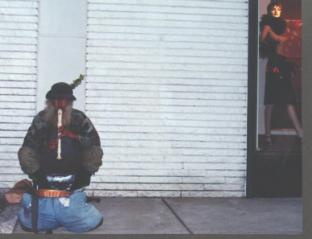 In recent years like the rest of the modern world, Denmark has had a growing problem of homelessness, mental illness and crime.
Many people hav
In recent years like the rest of the modern world, Denmark has had a growing problem of homelessness, mental illness and crime.
Many people hav e different theories for the cause of this, but everyone in Denmark - no matter what their problem is - has the right to equal free medical and
mental health help, a large monthly payment from the government, social help, shelter, and housing. Criminals receive very fair justice.
The death penalty is never used and even a murderer can go free after only several years in a prison where he or she is humanely treated. However, in recent years Amnesty
International has criticized Denmark
for human rights abuses of its
confined mentally ill and lack of due process to inmates and the accused in solitary confinement.
.
e different theories for the cause of this, but everyone in Denmark - no matter what their problem is - has the right to equal free medical and
mental health help, a large monthly payment from the government, social help, shelter, and housing. Criminals receive very fair justice.
The death penalty is never used and even a murderer can go free after only several years in a prison where he or she is humanely treated. However, in recent years Amnesty
International has criticized Denmark
for human rights abuses of its
confined mentally ill and lack of due process to inmates and the accused in solitary confinement.
.
CULTURE
Danish culture is based on deep humanitarianism (social consciousness & justice), health, family & Christian values. Though
most Danes do not go to church every Sunday, they share a strong faith in Christ. Tolerance to other faiths and religions is also a part of Danish culture.
Recently, the government legalized the ancient Shamanistic religion (belief in nature spirits) of the ancient Vikings. Due to Denmark’s willingness to accept refugees from war-ravaged Moslem countries, it is not unusual to see women wearing Islamic shawls downtown Copenhagen.
That said, Denmark is basically a homogeneous society, which means that most Danish people can look rather similar to foreigners
 and have a similar ethnic background. But that’s true of most small countries in the world.
and have a similar ethnic background. But that’s true of most small countries in the world.
 A great many folk ceremonies are celebrated throughout the calendar year, the most important ones, according to a survey in 2002, being Christmas and
Easter. There is often a blending of ancient Pagan traditions with Christian traditions, such as Saint Hans Evening (St. Hans is Denmark’s patron saint).
On this evening, nearly the longest day of the year at the summer solstice, huge bonfires are lit throughout the thousands of kilometers of Danish coastline, and a figure of a witch is set on fire to
symbolize that she needs to fly to Germany to bother them instead of Denmark for the rest of the year. Because Denmark is so far north, this evening may not get
really dark until after midnight.
A great many folk ceremonies are celebrated throughout the calendar year, the most important ones, according to a survey in 2002, being Christmas and
Easter. There is often a blending of ancient Pagan traditions with Christian traditions, such as Saint Hans Evening (St. Hans is Denmark’s patron saint).
On this evening, nearly the longest day of the year at the summer solstice, huge bonfires are lit throughout the thousands of kilometers of Danish coastline, and a figure of a witch is set on fire to
symbolize that she needs to fly to Germany to bother them instead of Denmark for the rest of the year. Because Denmark is so far north, this evening may not get
really dark until after midnight.
Danes are famous for their huge family gatherings at many of these festivals, where a traditional meal of potatoes and minced meats are enjoyed by the storfamilie (a Danish word
for Big Family – all the aunts, uncles, cousins and so forth). Once in a while, a family will bravely serve steak tartar, a traditional meal made of uncooked
chopped beef and raw egg.
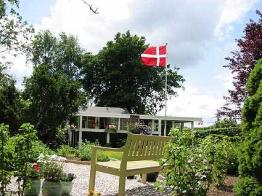 Denmark is very concerned that foods not be grown with a lot of che
Denmark is very concerned that foods not be grown with a lot of che micals. There are many strict laws that prevent certain foods from being sold if they contain too many chemicals, and all foods sold must show on the label if they contain genetically changed crop. Most supermarkets have departments where one can buy organic foods (vegetables and meats produced without pesticides or chemical fertilizers). All
eggs must show on the label if the chickens live in cages or roam free on the farm. Cows and other farm animals must be treated very humanely (no cruelty).
micals. There are many strict laws that prevent certain foods from being sold if they contain too many chemicals, and all foods sold must show on the label if they contain genetically changed crop. Most supermarkets have departments where one can buy organic foods (vegetables and meats produced without pesticides or chemical fertilizers). All
eggs must show on the label if the chickens live in cages or roam free on the farm. Cows and other farm animals must be treated very humanely (no cruelty).
Another interesting tradition is the summer cottage. Here a family may buy a small plot
of land with a tiny cottage, where they will live rather primitively for much of the summer and grow flowers and vegetables. These cottages exist in special colonies
where there are many others, and there are strict rules for how one behaves and maintains the land. For example, some colonies don’t allow electricity.
Other colonies only allow the residents to grow plants using ecologically aware and organic methods (no chemical fertilizers or pesticides). And unless one is
retired, it is illegal to live here year-round because the land is not taxed very much.
Danish people love beer. There is a story of the Vikings who invaded England a thousand
years ago, where the Viking chief shared Danish beer with the English king in his castle. The Danish tradition of saying “Skål” instead of “Cheers” or “To
your health,” when about to drink in a social setting is supposed to come from this story. The Vikings drank beer at that time from huge skull bowls, called a “skaal,”
and the tradition was to pour a little of each other’s beer into one another’s bowls. According to the fable, the Vikings blended some poison in their bowls, so
when the English king and soldiers around the table got some of the poisoned beer in their “little” mugs, they supposedly fell dead, while the Vikings who drank the whole bowl of poison only got a stomach
ache. This is a fictional story of how Denmark conquered England. Modern Danish beer is sold all over the world. The beer culture, which until a few years ago even allowed children to buy beer in stores, is one of the reasons for Denmark’s alcoholism problem.
Interestingly, cigarette smoking is a huge part of Danish culture. Half of all Danish parents smoke and allow their older children to smoke. This of course has led to a huge number of lung and heart diseases in
Denmark, especially among women.
 On the other side of the coin, Danes try very hard to live a healthy lifestyle. Until a few y
On the other side of the coin, Danes try very hard to live a healthy lifestyle. Until a few y ears ago, one-third (1/3) of all traffic to and from work, school and activities was partly by bicycle. Most
cities have four sets of traffic lights at the major intersections (for busses, motor traffic, bicyclists, and pedestrians [walkers]), and many main streets have three levels of pavement -- again for motor
traffic, bicycles and walkers. This system was built in the 1970’s to encourage the use of bicycles when suddenly oil prices became very high.
It is quite common to see a whole family bicycling together with the baby in a special carrier. Even in bad weather or when snowing, Danes will use their
bicycles to get to work or school. Often the family will spend a whole vacation by bicycling long distances and camping. Public
transportation with busses, trains and a new subway system in the Capitol is quite efficient.
ears ago, one-third (1/3) of all traffic to and from work, school and activities was partly by bicycle. Most
cities have four sets of traffic lights at the major intersections (for busses, motor traffic, bicyclists, and pedestrians [walkers]), and many main streets have three levels of pavement -- again for motor
traffic, bicycles and walkers. This system was built in the 1970’s to encourage the use of bicycles when suddenly oil prices became very high.
It is quite common to see a whole family bicycling together with the baby in a special carrier. Even in bad weather or when snowing, Danes will use their
bicycles to get to work or school. Often the family will spend a whole vacation by bicycling long distances and camping. Public
transportation with busses, trains and a new subway system in the Capitol is quite efficient.
Literature and the arts is a very big part of
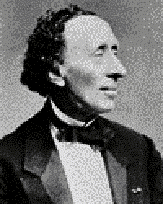 Danish culture. Most of the world has heard of the famous son of a shoe cobbler, Hans C
Danish culture. Most of the world has heard of the famous son of a shoe cobbler, Hans C hristian Andersen, who dazzled everyone with his deeply spiritual fairy tales. He is also known for his
drawings and silhouette cutouts. Karen Blixen (Isak Dinesen) is another famous folk tale author whose autobiography was made into an award-winning film several years ago: “
Out of Africa.” Three other Danish authors have won the Nobel Prize for literature.
hristian Andersen, who dazzled everyone with his deeply spiritual fairy tales. He is also known for his
drawings and silhouette cutouts. Karen Blixen (Isak Dinesen) is another famous folk tale author whose autobiography was made into an award-winning film several years ago: “
Out of Africa.” Three other Danish authors have won the Nobel Prize for literature.
Danish children are treated to a rich culture of folk music as they go through kindergarten all the way up past high school
(gymnasium). Often the whole school gets together to sing beautiful and simple songs. There is even a tradition at the
end of the school year where all the children and teachers link hands and dance while singing and snaking through all the school’s classrooms.
Due to the state (government) support of the arts, Denmark is rich with opera, ballet, theatre, filmmaking and music festivals.
Some people suggest that Copenhagen is one of the world’s capitols for Jazz and classical music. Pianist and comedian Victor Borge traveled the world to
bring laughter and music to everyone. One of the world’s largest concerts for young people, Roskildefest, takes place every summer in a large city 40 kilometers
outside of Copenhagen. Unfortunately, in 2000, several people were crushed to death at the three-day outdoor festival. In
the past few years, the Dogme films, a series of modern movies that try to do the opposite of the films from Hollywood has won many international prizes. Since the
19th century and the introduction to the world of a special Danish style, ballet has also been very important to the nation’s culture. The Queen, an artist herself, often goes to the ballet.
 Other areas of Danish culture include science.
Other areas of Danish culture include science.  Sixteenth Century astronomer Tycho Brahe discovered that comets were not objects in the atmosphere and that the moon’s orbit around the Earth was not a
perfect circle. The father of modern astronomy, Johannes Kepler, used Tychos’ system to write his laws of planetary movement.
Physicist Niels Bohr is as respected as Einstein for his theories about the basic scientific laws that guide everything in the universe.
Sixteenth Century astronomer Tycho Brahe discovered that comets were not objects in the atmosphere and that the moon’s orbit around the Earth was not a
perfect circle. The father of modern astronomy, Johannes Kepler, used Tychos’ system to write his laws of planetary movement.
Physicist Niels Bohr is as respected as Einstein for his theories about the basic scientific laws that guide everything in the universe.
Some of the finest porcelain known is Royal Copenhagen and Georg Jensen of the late 19th Century created special silver
designs that are still being produced. Danish furniture and architecture is some of the world’s most respected, including the Danish-designed Opera House in
Sydney, Australia. (Because it was so expensive, its architect, Jon Utzon, has never gone back to Australia to see it finished).
A very important part of Danish culture is protecting the environment. Because it is
such a small country but which uses all the modern conveniences of an industrial nation, Denmark can quickly become very polluted or run out of water. Therefore
there are very strict laws about not using too much water or electricity, and most garbage is recycled in some way. There are special electricity generators that
burn garbage, and glass is always reused. Most bottles and plastic containers have a special tax on them that is refunded when the empty bottle is returned to the
store at special electronic booths. Alternative sources of energy are a big part of every day life, as anyone who takes a train ride in the country can see.
Every few miles rises a huge steel pillar from a farm or countryside upon which gently hums the giant blades of an electric wind generator.
EDUCATION
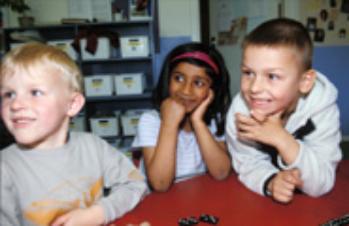 Almost all education, even b
Almost all education, even b eyond a university education, is free to all Danish residents. All children must attend kindergarten (børnehave)
and grade school (folkeskole). The school year is very long for Danish children: from the beginning of August to the following July. The average Dane goes through 16 years of
education before beginning to work as an adult, and even in the workplace a lot of importance is placed on continuing education. English is now taught to all
students but Danish is still the national language.
eyond a university education, is free to all Danish residents. All children must attend kindergarten (børnehave)
and grade school (folkeskole). The school year is very long for Danish children: from the beginning of August to the following July. The average Dane goes through 16 years of
education before beginning to work as an adult, and even in the workplace a lot of importance is placed on continuing education. English is now taught to all
students but Danish is still the national language.
After graduating from primary school (folkeskole) at grade 9, teenagers have several choices to continue their education.
If they have good enough grades and they wish to, they can go to a pre-university. three-year program at a gymnasium (high school). However, many chose to instead use this time at a vocational school where they take general courses in language and psychology as well as courses specific to their chosen field of work. And in Denmark, there are many vocational schools, from those that teach one to be a librarian or social worker to those that train welders, artists, shipbuilding and auto mechanics.
Many of these schools remind one of the ancient European trade guilds, where one became a master of a trade under a craftsman’s supervision.

 In a gymnasium, the pace is very fast and very hard, and at the end of the three years the student must take perhaps the hardest test of his or her life: the studentereksamen.
This exam will determine if the student will be allowed to study at a university. There are only a small number of openings each year at Denmark’s five
universities and several trade colleges. Some areas of study, such as medicine and economy, have hundreds of applicants competing for just one available class seat.
The other colleges, such as for agriculture and journalism also have a lot of applicants. So that test one takes in his or her last year of high school is
very important. But once that test is passed, all of Denmark celebrates with a huge party for the graduates. The graduates parade through the village and city streets in horse drawn wagons, singing and being a little crazy. The white cap with the symbol of his/her study specialty they are given upon
graduation is an old tradition, and one the student will cherish the rest of his or her life.
In a gymnasium, the pace is very fast and very hard, and at the end of the three years the student must take perhaps the hardest test of his or her life: the studentereksamen.
This exam will determine if the student will be allowed to study at a university. There are only a small number of openings each year at Denmark’s five
universities and several trade colleges. Some areas of study, such as medicine and economy, have hundreds of applicants competing for just one available class seat.
The other colleges, such as for agriculture and journalism also have a lot of applicants. So that test one takes in his or her last year of high school is
very important. But once that test is passed, all of Denmark celebrates with a huge party for the graduates. The graduates parade through the village and city streets in horse drawn wagons, singing and being a little crazy. The white cap with the symbol of his/her study specialty they are given upon
graduation is an old tradition, and one the student will cherish the rest of his or her life.
University life is also fast paced. Unlike most places in the world, a bachelor’s
degree can be earned in three years. If their grades are good enough, they then have the choice of entering a two-year masters degree program, or medical or law
school. Here again, there is even more competition for each available space. Finally, one can enter the doctorates
program (PhD).
The entire education process is free, and at the high school and college levels the government gives the student a special living
allowance (SU) so that he or she can pay for food and rent. Some students can apply for grants to study in another country if they can prove it will benefit Denmark
and the courses aren’t offered at home. Perhaps the hardest thing for a student is to find a place to live if the school is far away from the family home.
As an adult, there is always the opportunity to study a craft or a specific subject, like a language, religion or creative writing,
at a special school called Højskole. These schools are scattered all over the countryside but unless given a very special grant, such as for therapy, it usually costs a little bit of money to take classes here.
There are also several private schools, especially Catholic or other religious-based schools, but due to high taxes and free education, there are not many.
GEOGRAPHY & NATURE
 As already explained in the
Introduction, Denmark is found a few hundred kilo
As already explained in the
Introduction, Denmark is found a few hundred kilo meters south of the Arctic Circle. Due to the warm Gulf Stream ocean current, the
climate in Denmark is not too cold in the winter but not very warm in the summer. A great many storms blow in year-round from the many seas that surround all of
Denmark. Only 64 kilometers of land is directly connected to another country, Germany to the south. To the north, across seawater, is Norway and Sweden. Several hundred kilometers out to the North Sea are a cluster of islands called the Faeroe
Islands. Their language, though Danish, is actually called faroe’esk since the dialect is so unique. These islands are very different from the rest of Denmark, because like nearby Scotland, they are jagged, cold and rain-swept rocks that rise out of the sea.
meters south of the Arctic Circle. Due to the warm Gulf Stream ocean current, the
climate in Denmark is not too cold in the winter but not very warm in the summer. A great many storms blow in year-round from the many seas that surround all of
Denmark. Only 64 kilometers of land is directly connected to another country, Germany to the south. To the north, across seawater, is Norway and Sweden. Several hundred kilometers out to the North Sea are a cluster of islands called the Faeroe
Islands. Their language, though Danish, is actually called faroe’esk since the dialect is so unique. These islands are very different from the rest of Denmark, because like nearby Scotland, they are jagged, cold and rain-swept rocks that rise out of the sea.
Denmark is mostly made up of sandy deposits left over from the last Ice Age’s glaciers. As
the icecap melted, the sand and rocks scraped up along Norway and Sweden melted and created most of Denmark. Therefore, there are no mountains at all in Denmark,
just a lot of rolling hills and gentle farm countryside. Because the country is so flat, especially the southern region of the peninsula of Jutland and the island of
Lolland, flooding from the sea has been a problem that had to be solved like in the Netherlands, with dikes. At one time after one of the ice ages, most of Denmark
was underwater.
Jutland Peninsula is divided by a glacial ridge (from the ancient Ice Age). It is this
ridge that gives Denmark some of its hilly forests, like the Rebild Hills. None of Denmark’s forests are actually original. Even
the wilderness preserves are artificially planted forests. There is often a sense in the middle of a Danish forest that a thousand other people have stepped in
exactly the same spot. Western Jutland is sandy and marshy, and the soil is not very fertile (poor for farming). The
eastern part is much more fertile and therefore has a lot of dairy and other sorts of farms. A small river is also found here, but in fact, there are no rivers in
Denmark because there are no mountains to create them. Denmark is full of small lakes and streams that are called an “å”. Denmark
also has many fjords, which are sort of like an enclosed bay or river mouth formed by glaciers that carved the land up. But unlike the dramatic mountainous fjords of Norway, all of Denmark’s fjords are surrounded by gentle hills.

 In the southeastern part of the capitol island of Zealand (Sjælland) and along the island of Møn are found remarkable chalk cliffs. These
are remnants of ancient sea life that turned into chalk deposits. Not far from the port city of Køge, south of Copenhagen, is a cliff that rises some 45 meters up
from the sea where there is a tiny old church about to fall. In the middle of a church service in 1928, the back end of the church collapsed into the sea along with
a bit of the cliff, and several choir members died. The church is no longer used but is now a museum.
In the southeastern part of the capitol island of Zealand (Sjælland) and along the island of Møn are found remarkable chalk cliffs. These
are remnants of ancient sea life that turned into chalk deposits. Not far from the port city of Køge, south of Copenhagen, is a cliff that rises some 45 meters up
from the sea where there is a tiny old church about to fall. In the middle of a church service in 1928, the back end of the church collapsed into the sea along with
a bit of the cliff, and several choir members died. The church is no longer used but is now a museum.
Though there are no original wild forests in Demark, it is full of wildernesses and parks. Some
of these forests are farmed for their trees but many are left alone for the animals that live there. And there are a lot of interesting animals in Denmark, including
one poisonous snake: the
hugorme. Forest ants are also rather interesting, because they
live in colonies of
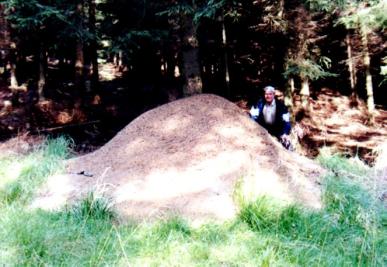 several hundred thousand and build anthills of up to a meter high and two meters wide.
several hundred thousand and build anthills of up to a meter high and two meters wide. These ants build huge mountain nests of bits of wood, facing into the sun so that in the cold of winter, the sun shines on the dark surface of the hill and
warms up the ants. It is a remarkable sight to see in the forest.
These ants build huge mountain nests of bits of wood, facing into the sun so that in the cold of winter, the sun shines on the dark surface of the hill and
warms up the ants. It is a remarkable sight to see in the forest.
Denmark has perhaps fifty wild mammals (warm blooded with hair) including foxes, seals, many types of deer and elk and over 200 wild
birds including many hawks. Perhaps only a few of the fairy tale storks are now making their nests in Denmark. Hunting
for deer and birds like ducks is allowed in some of the forests. Denmark’s national symbol, the swan, is strictly protected. These
huge graceful birds often mate for life and are found in city parks and in the wilderness. Insects are endless as are other large insect-type creatures like the
giant millipede. Because of global warming and people who bring in animals from other countries, Denmark gets a few extra, unwanted animals every year.
This often is a problem for farmers who have to deal with new pests.
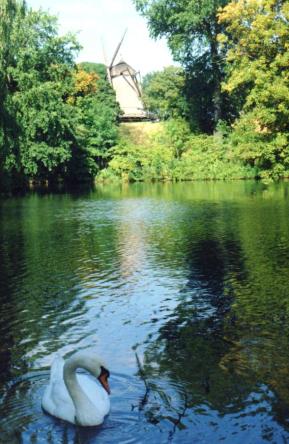 Denmark is a land with fo
Denmark is a land with fo ur seasons and therefore there are many interesting plants, many of which will lose their leaves in the winter. Pine
and fir trees (evergreens) that have thin leaves year round are also abundant. One particularly bothersome plant for those visiting the forests or parks is the
stinging nettle. This bushy perennial (they die down in the winter but pop up again in spring) is found everywhere and has millions of invisible needles on their
leaves that pierce the skin if you touch one. The pain is only temporary and people actually collect the plant because it is a healthy wild vegetable that can be
made into soup or bread.
ur seasons and therefore there are many interesting plants, many of which will lose their leaves in the winter. Pine
and fir trees (evergreens) that have thin leaves year round are also abundant. One particularly bothersome plant for those visiting the forests or parks is the
stinging nettle. This bushy perennial (they die down in the winter but pop up again in spring) is found everywhere and has millions of invisible needles on their
leaves that pierce the skin if you touch one. The pain is only temporary and people actually collect the plant because it is a healthy wild vegetable that can be
made into soup or bread.
Fungus plants, like wild mushrooms, are found everywhere in the Danish woodland. Many
gather these mostly edible plants to cook tasty sauces. But caution must be used. There are many very poisonous, even
deadly, mushrooms.
In brief, Greenland (Kalaallit Nunaat,) the world’s largest island, sits mostly within the Arctic Circle not far from Canada in
the North Atlantic Ocean. It is 2,650 kilometers long and up to 1000 kilometers wide. New oceanographic (the study of
oceans) measuring suggests that even the North Pole is part of Greenland’s and thus Danish property. Ninety percent (90%) of the island’s land is covered by an
ancient ice cap, and the remaining bit is mostly rock due to a sort of polar desert where there is very little snowfall or it is far enough south to melt a little. It
is here you will find most people. This ice cap is the result of many thousands of years of snow accumulation that over time became crushed into ice where the air in
the snow has been squeezed out. In 1981, scientists bored out a 2 and ¼ kilometer deep core of ice but most scientists agree that the ice cap averages nearly three
kilometers deep and in places can be more than four kilometers deep. The ice is so heavy that the middle of Greenland has been dented. Since the 1950’s scientists have noticed that the ice growth on Greenland is
reducing by some 40%, and most think this is because the worlds climate is becoming warmer.
Billions of tons of ice fall into the ocean every year from this ice cap, and become the huge glaciers that are a problem to ships
crossing the Atlantic Ocean. It was one of these ice chunks that sank the world’s largest ship, the Titanic.
Greenland has no forests but there are actually quite a few large animals here with some trees and tundra grassland to the south.
Potatoes can even be grown in southern Greenland, which is part of the diet of the Inuit Eskimo people that have made their home here for thousand of years. These
native people live mostly by hunting and fishing but must import much of their food to survive. Some have learned to raise sheep.
A few minerals, such as gold and uranium, have been found here and sold. A very few Eskimos live in traditional igloos (ice huts) when traveling, but most
live in modern houses within small villages, where the children are required by law to go to school. Native Greenlanders often hunt seals and whales, sometimes
by kayak (a small canoe-like boat) and sometimes by dogsleds. Godthåd (Nuuk), a small city of 11,000 people to the south, is Greenland’s capitol.
Only about 60,000 people live in Greenland, including soldiers of NATO that have a huge military base that is part of the American nuclear missile protection system.
Why this huge chunk of cold mountains and ice is called Greenland is interesting. The
Vikings found it more than a thousand years ago and called it “green” to try and lure more people from their Scandinavian home to live here. There is very little
here that is green; it is mostly all white with snow and ice.
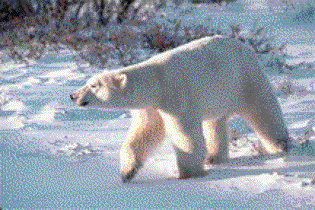 Perhaps the best-known animal fo
Perhaps the best-known animal fo und in Greenland is the polar bear (or as Danes call them, ice bears). These huge and dangerous animals live mostly in the northern and eastern parts of the
gigantic island. Here also can be found walruses, reindeer, wolves, the arctic fox, hares (a large rabbit) lemmings (a large rat), ermines (a type of mink) and musk
oxen in the largest national park of the world (the size of France and England put together).
und in Greenland is the polar bear (or as Danes call them, ice bears). These huge and dangerous animals live mostly in the northern and eastern parts of the
gigantic island. Here also can be found walruses, reindeer, wolves, the arctic fox, hares (a large rabbit) lemmings (a large rat), ermines (a type of mink) and musk
oxen in the largest national park of the world (the size of France and England put together).
INDUSTRY & AGRICULTURE
AND ECONOMY
The Danish economy in the past few decades has been very stable, and seems to be getting better each year.
If we use the American dollar instead of the difficult-for-foreigners-to-understand Danish Kroner (DKK), the Gross Domestic Product (what all of Denmark earns as a nation) is just under 200 billion US
Dollars each year. This is a very large amount of money for such a small country. It is this number that is used to figure out how much Denmark should contribute to
the United Nations. The average Dane
earns about 36,000.00 US
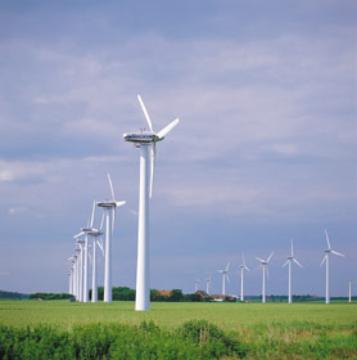 Dollars each
Dollars each  year. Unlike most developed countries, there is not a huge difference between the rich and the poor. Yes, there are differences, but not as much as in most, and this is because of a public attitude that to an extent, wealth should be shared. This
means that the very wealthy pay more than most countries to help the poorer people. In the past few years, there is a movement to allow the rich to become richer and
the poor to become poorer, one of the reasons perhaps for why there is now more homelessness in Denmark.
year. Unlike most developed countries, there is not a huge difference between the rich and the poor. Yes, there are differences, but not as much as in most, and this is because of a public attitude that to an extent, wealth should be shared. This
means that the very wealthy pay more than most countries to help the poorer people. In the past few years, there is a movement to allow the rich to become richer and
the poor to become poorer, one of the reasons perhaps for why there is now more homelessness in Denmark.
Let’s look at how Denmark makes its money. A lot of it comes from agriculture and
fishing. In reality, Denmark produces enough food each year to feed 15 million people, three times more people than live n Denmark. This is because Denmark has learned how to use a small bit of land (1/3 the size of England) to produce huge amounts of food. Dairy and meat
animals as well as grain (wheat, rye, barley, corn etc.) potatoes and other root and vegetable crops are grown in abundance in Denmark. Due to strict laws to protect
the environment, Danish farmers have learned to use less dangerous chemicals to fertilize the soil and increase productivity.
Because Denmark owns a huge amount of the oil and gas fields in the North Sea, in the past few decades the country has imported less
and less energy sources. Alternative energy sources, such as wind-powered generators, also have contributed to Denmark’s energy independence and export.
Two-thirds (2/3) of Danish trade occurs within the European Union, and most of that is with its southern neighbor, Germany.
Five other countries are important trade partners with Denmark and they are Sweden, Norway, Great Britain, Japan and the United States.
Denmark’s main exports (what it sells to other countries) are meat (such as Danish ham), dairy products and eggs, fish, cereals
and grain products, sugar and honey, medicine, oil and gas products, manufactured goods, and arts and crafts. Denmark also makes a lot of money from tourism and from
the many business conventions that take place in Copenhagen. Internet computer businesses are also very important to the Danish economy.
A recent international study wrote that Denmark has more high-speed Internet connections per person than any other country in the world.
Since Denmark has a huge social program, one-third (1/3) of all the money the Danish government uses goes to some form of welfare.
This means that more than most countries in the world, people work for the government in some way to manage this bureaucracy. It also is the reason for such a high
tax (about 50%).
In order to protect Danes, huge and powerful unions help ensure that the average Danish worker gets at least one month of vacation a
year, help parents stay at home with a newborn child for many months, get a good wage and that a worker is not required to work more than 37 hours a week.
Because Denmark is so small, it has to import (buy) certain minerals and other resources in order to make products, such as wood for
houses and metal for machinery. For example, Denmark buys from other countries nearly twice as much metal as it digs out of the ground, but then manufactures out of
this metal and sells to other countries much more machinery than it imports. Denmark sells to other countries twice as much fish as it buys, but has to buy nearly
four times more coffee and spices than it sells. The reason why Denmark, which does not have the right climate to grow coffee, can still sell coffee to other countries is because it will buy coffee wholesale (in huge quantities) from a
tropical country, and then make specialized coffees out of it that it can sell to other countries at a much higher price.
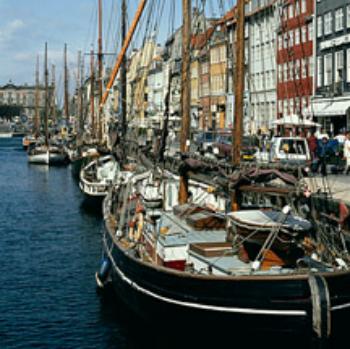
 Many decades ago, a nation’s wealth was measured by how much gold it had. This began to change after World War 2, when most of the world agreed to base wealth more on a nation’s financial strength than the gold it kept stored.
In other words, if one country uses US Dollars ($) for a currency and another country uses English Pounds (£), then the exchange value of the two types of currencies (money) is based on each nation’s economic health. Much of this “economic health” is now
measured by special banks and various Stock Exchanges in the world, like the New York Stock Exchange on Wall Street or even Denmark’s own Københavns Fondsbørs, where people, corporations and even nations
invest money in large businesses. In other words, they buy a piece of the business. These investments can make huge
fortunes in countries or can ruin countries overnight, such as what happened to the world after the Stock Market Crash of 1929, which some blame for World War II.
Many decades ago, a nation’s wealth was measured by how much gold it had. This began to change after World War 2, when most of the world agreed to base wealth more on a nation’s financial strength than the gold it kept stored.
In other words, if one country uses US Dollars ($) for a currency and another country uses English Pounds (£), then the exchange value of the two types of currencies (money) is based on each nation’s economic health. Much of this “economic health” is now
measured by special banks and various Stock Exchanges in the world, like the New York Stock Exchange on Wall Street or even Denmark’s own Københavns Fondsbørs, where people, corporations and even nations
invest money in large businesses. In other words, they buy a piece of the business. These investments can make huge
fortunes in countries or can ruin countries overnight, such as what happened to the world after the Stock Market Crash of 1929, which some blame for World War II.
All this is hard sometimes to understand, because if one country becomes a little poor, then why not just print a lot more money? But that doesn’t work because then each piece of money is worth even less.
For a while the American Dollar, German Mark and English Pound (Sterling) were considered the international currencies (types of
money) that the world used. Now there are international organizations and banks that look at each country and figures out how much their money is worth in comparison
to others. This helps a farmer in Denmark, who uses Danish Kroner (DKK), sell raw milk to a dairy factory that makes yogurt in Germany, which uses the Euro Dollar
(€). It all becomes very complicated, especially when wealthy American or European nations trade with poorer, developing countries.
This also leads to the problem where large companies move their factories to poorer countries, where local laws don’t prevent child labor and where the factory owner pays very little to the worker.
RELIGION & SPIRITUALITY
The University of Copenhagen is one of the oldest Catholic universities in the world, founded in 1479 as a center of Roman Catholic
theological learning in northern Europe. In 1537 all that changed due to the Lutheran Reformation of Germany that swept through most of Scandinavia, and the
university closed its ties to the Vatican for many centuries. The university and nation, though still mostly Lutheran, has again opened the door to Catholicism.
If we can take a time machine and go back in time to long before Jesus Christ came to Earth, long before even the Caesars of the
Roman Empire that controlled the land in Israel where Christ taught, most of the world was made up of scattered groups of people who tried to form cultures out of ideas around some sort of spiritual belief
system. In Egypt along the Nile River under the hot desert sun, evolved rather peaceful people who learned how to farm using the river.
This became the basis for a religion where the king or queen (pharaoh) was considered a god, and upon dying one would take a boat ride toward the sun. At
around the same time, the Jewish people slowly learned to understand through the prophets that the Son of God would one day be born in Israel who would explain the truth about God.
Christ was born at a time when the Jewish people had gone through hundreds of years of slavery under Egypt, Greece, Rome and other powerful cultures.
When Christ was born, Denmark was not a country but a collection of pagan tribes with similar spiritual beliefs - from Germany to
the near-polar regions of what is now northern Norway. The land and climate was harsh. The Danes (Norse) believed
that the universe was like a huge ash tree (Yggdrasil), with nine worlds separated into three levels (similar to heaven, Earth and hell). It was a very complex
universe filled with strange Gods and beasts in lands full of ice, fire, poisonous rivers and emptiness. The Norse felt that life began when volcanic fire and water
met, and the ice began to melt – which is interesting since Scandinavia began to be settled by people after the last ice age. Out of this huge explosion of
volcanic fire and melting ice, awoke a sleeping giant (Ymir) who was kept alive by a cosmic cow’s milk. When this cow was hungry, she licked salty ice, and out of
this ice came the grandfather of three chief Gods of Norse mythology, including the one most of the world knows: Odin, with his huge hammer that is supposed to make thunder.
All the worlds in the huge tree were often filled with violence, with many bloodthirsty battles between the creatures that lived
there, even in the pagan Danish idea for heaven (Valhalla). Since the Norse believed that the world was already doomed to chaos and destruction (Ragnarok), the
fierce Viking warriors were not afraid to torture and hurt the weaker cultures they met as they learned to travel and sail. The entire concept of this pagan
spirituality is based upon the idea that this huge tree holds everything together and that the tree is in constant danger of attack. A huge snake tries to eat its
roots while deer and goats eat its leaves and an eagle sits at the top, also making trouble.
In the middle of the fifth century after Christ in what is now Scotland north of England, an Irish Catholic monk of the royal family
established many monasteries. Ireland had already been partly converted from pagan Druid beliefs to Catholicism 200 years earlier by St. Patrick.
Due to the works of these two priests, an English Benedictine monk (St. Boniface) traveled to near the Danish border in 716 AD where he assumed that Catholicism was already practiced.
What he found instead was a very brutal culture that had mixed the violence of Norse mythology with Christianity. He and his fellow priests traveled
throughout Germany and southern Denmark to reestablish the more loving principles of Christ’s teachings. He was killed as a martyr in 754 AD.
Many years later, another Benedictine monk, St. Ansgar, traveled deep into Denmark and Sweden to spread Christ’s teaching.
At the same time, Denmark had slowly become a union of tribes under one king who had managed to conquer most of northern Europe
including England. This king, Knud or Canute, was very spiritual and had become Catholic. But for his people, the Vikings, it took a long time to transform their violent beliefs to the more
peaceful thoughts of Christ’s teachings. This was a problem throughout the known world, where pagan and often-violent beliefs overlapped Christ’s teaching of
compassion and love. Far away and even in Rome, people abused the political power of being Catholic, forgetting Christ’s teaching in the process, and the
common people were hurt.
This is one of the things that led a German Augustinian monk, by the name of Martin Luther, to believe that no matter how many good
deeds a person did in his or her life, humans were already condemned in the eyes of God as sinners. In 1510 he went to Rome to appeal to the head of his Augustinian
Religious Order. While in Rome he did many painful penances to find peace of mind. He did not find inner peace and
returned to Germany an angry priest who was now a professor of theology at the local university. Here he studied and taught some of the religious philosophies of St.
Paul and St. Augustine -- about how man is too sinful to reach heaven through good deeds.
Then an incident in 1517 changed everything. A Catholic nobleman who was abusing his
position of authority traveled throughout Germany, selling for money a ticket out of hell or purgatory. Angry, Martin Luther wrote a long article in Latin
criticizing such practices and posted it on the door of a German church. Someone then took this paper down and after translating it to German, printed it as a book
so many people could read it. The original article was not a direct attack on the Catholic Church but a criticism of some of the people who abused its authority.
When the German archbishop read the small book, he sent a copy to the Vatican, asking Pope Leo X to stop Martin Luther from criticizing the Church. This led
to a lot of arguing between good and bad Catholic bishops and kings, until in 1521 Martin Luther was excommunicated from the Catholic Church. At this time, most of
the lands south of Denmark were ruled under the Catholic emperor, Charles V, of the Holy Roman Empire.
Ideas of democracy and individual rights were beginning to blossom while huge monarchies struggled to stay alive as they waged wars
on one another. Thus Martin Luther - though he himself was from a wealthy family - became popular to the common and poor people of Germany.
The neighboring kingdoms, including Denmark, became worried about revolutions, so many of them banned
 Catholicism. The Catholic king of Denmark, Norway and
Catholicism. The Catholic king of Denmark, Norway and  Sweden (King Christian II) was a very cruel man in the early 1500’s, who abused the power of the Catholic Church.
He killed anyone that he didn’t like. In 1522 the wealthy landowners of Denmark were so tired of his brutality that they kicked him out and asked his uncle, Frederick I, to take over.
Many wealthy and noble people in Denmark were afraid that because King Christian II had behaved so badly, the common people would give up their Catholic faith and embrace the radical Lutheran ideas
coming up from Germany. But the bad practices of some wealthy Catholics already had made many peasants upset. The rich Catholics who abused the power of the Church complained to the new King Frederik but he said, “The King governs the land and people but not the soul.”
He worked hard to protect peace between everyone at a very difficult time in history.
Sweden (King Christian II) was a very cruel man in the early 1500’s, who abused the power of the Catholic Church.
He killed anyone that he didn’t like. In 1522 the wealthy landowners of Denmark were so tired of his brutality that they kicked him out and asked his uncle, Frederick I, to take over.
Many wealthy and noble people in Denmark were afraid that because King Christian II had behaved so badly, the common people would give up their Catholic faith and embrace the radical Lutheran ideas
coming up from Germany. But the bad practices of some wealthy Catholics already had made many peasants upset. The rich Catholics who abused the power of the Church complained to the new King Frederik but he said, “The King governs the land and people but not the soul.”
He worked hard to protect peace between everyone at a very difficult time in history.
When King Frederik I died, King Christian III was crowned, and in some places the violence of the pagan times returned.
Churches were burned and Catholics were tortured. Though it was only a few bad Catholic bishops and princes that had led Martin Luther – a man with a
troubled soul – to turn his back on his Church, many kings and leaders seized the opportunity of this and other protestant reformations to make their power over the people stronger.
This is the nature of humanity when Christ’s teachings are forgotten.
Over the centuries, in spite of prosecution, the Catholic Church has survived in Denmark.
The Lutheran Church of Denmark is actually government controlled, with the king or queen as the church’s highest director. The Danish name for the religion
is Folkekirken or “The State Church.” Even though only 4% of Danish people regularly go to church, the Folkekirken is totally supported by taxes that everyone in Denmark pays.
In the past century, and especially in recent years, there has been a movement to separate religion from government, because many people feel that a person’s spiritual belief should not be supported or
rejected by any government. The Catholic Church in Denmark, including its private schools and charity works, are entirely supported by a small percentage of generous Catholics.
Denmark has a strong need for many new Catholic priests and nuns to serve.
Because Denmark has helped so many unjustly hurt people from Islamic countries, the Muslim faith is now Denmark’s second largest
religion: at just over 1%. There are some who are worried about so many Muslims in Denmark. But most people are wise
enough to understand that God loves everyone equally.
GOVERNMENT & ADMINISTRATION
As has already been explained, Denmark has been a kingdom ruled by a king or queen for over a thousand years.
After the United States and France got rid of royal rule in the 17th century though revolutions, many other kingdoms were worried that the ideas of democracy would also cause a local
revolution. The same happened in Denmark and in 1849, the King introduced a new Constitutional Law (Grundloven) that established the separation of power between the
court system and a type of democratic rule by election. Thus King Frederik VII gave up his absolute power over everything and everyone.
This new constitution allowed every male over 30 who was not a servant, criminal or receiving charity to vote for a representative parliamentary government (Folketinget and Landstinget) that shared power with the King. When this “democracy” began - due to the rules of who could vote -
only 15% of Danish adults had the right to vote.
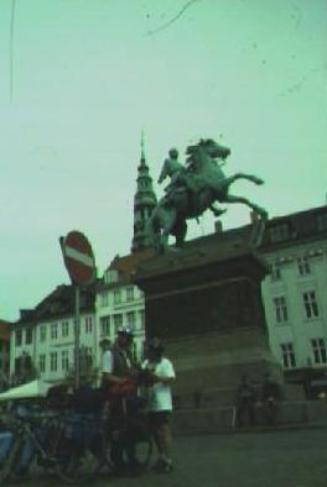 Some of the rights guaranteed by the C
Some of the rights guaranteed by the C onstitution of 1849 included that anyone arrested must see a judge within a day, as well as guaranteeing the rights of individuals to think and behave as they
liked so long as it didn’t disturb or hurt others. It was also one of the first constitutions in the world to offer public assistance and free education to the
needy. But it was not until 1916 that the court system allowed an accused person to be tried by his peer (a jury). And
the King still held on to his right to choose from the Parliament who would run the government as its prime minister (statsminister).
onstitution of 1849 included that anyone arrested must see a judge within a day, as well as guaranteeing the rights of individuals to think and behave as they
liked so long as it didn’t disturb or hurt others. It was also one of the first constitutions in the world to offer public assistance and free education to the
needy. But it was not until 1916 that the court system allowed an accused person to be tried by his peer (a jury). And
the King still held on to his right to choose from the Parliament who would run the government as its prime minister (statsminister).
During World War I, women and poor people were given the right to vote, and the parliament (Folketinget) became a more
democratically elected government. A lot of influential people in Denmark from the late 1800’s to after World War II wanted to reform the Constitution to make it
even more democratic and socialistic. The idea was that every person, no matter how wealthy or poor, should have the same basic freedoms and opportunities to get
ahead in life. This meant that the wealthy should contribute more to the poor. It also included the addition of more
human-rights laws.
The right of all individuals to have more personal freedoms (choice and expression) in his or her life became a law in 1953, when
the Constitution again was completely rewritten. Some of the laws from that new Constitution (Grundlov) in 1953, included having huge elections (folkeafstemning)
where everyone could vote whenever the government wanted to make a big change in the way society should live. This has become a very big issue in the way Denmark decides to join the European Union (EU). The new law also gave more humane treatment to people
arrested or those hospitalized because they have a mental illness. The new Constitution of 1953 also gave more independence to the two foreign lands that Denmark
controls: The Faeroe Islands and Greenland. Finally, for the first time in Denmark, the new law gave a woman the right to become Queen. Until 1953, only men were officially allowed to sit on the Danish Throne as a king.
The Danish government is divided into three bodies. Highest up is the king or queen, who symbolically rules Parliament. In 1972 until the present, this person has been Queen Margrethe II – which
this book has described in a previous chapter. Though she is the official leader of Denmark, she has no real power. She is a symbol, and most Danes do not want to get rid of the monarchy even though it is very expensive. Like a country’s flag, she represents
the life and values of the country. The Queen or King also represents Denmark when presidents or prime ministers from other countries come on state visits.
The King or Queen also must sign every new law passed by Parliament (Folketinget).
The Folketinget is the body that makes laws. Every four years Denmark has an election
to decide who these lawmakers will be. Like most countries, these people (candidates) belong to many political parties that have very different ideas about
government. The biggest of the nearly two-dozen parties in Denmark are the Social Democrats and Venstre (Left). Traditionally,
the Social Democrats have been in favor of laws that help poor people and socialistic ideals while the Venstre party has been in favor of capitalism and less government control.
Because there are so many political parties, and it is almost impossible for a single person or party to get a majority vote, many of them work together to form
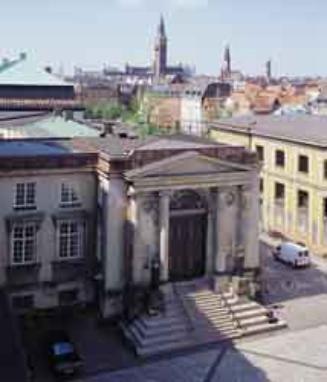 large coalitions that are either for more socialism or for more capitalism.
large coalitions that are either for more socialism or for more capitalism.
 Then there is the executive government, which are the Prime Minster (statsminister) and his or her ministers. These
are usually the people who got the most votes in the parliamentary election of every four years, but the King or Queen must approve them. The Prime Minister and his Ministry are responsible for the actual running of the country – including making treaties with other countries or going to war – much like a president and his
or her Cabinet. If the Parliament cannot agree over a serious problem, the Prime Minister has the right to dissolve (cancel) the Folketinget and force an emergency
election of a new Parliament.
Then there is the executive government, which are the Prime Minster (statsminister) and his or her ministers. These
are usually the people who got the most votes in the parliamentary election of every four years, but the King or Queen must approve them. The Prime Minister and his Ministry are responsible for the actual running of the country – including making treaties with other countries or going to war – much like a president and his
or her Cabinet. If the Parliament cannot agree over a serious problem, the Prime Minister has the right to dissolve (cancel) the Folketinget and force an emergency
election of a new Parliament.
The Court System in Denmark is completely independent of the rest of the government. Although
the King or Queen appoints the judges, these judges are lawyers who have been selected by an independent committee. When a person is accused by the police of a crime,
that person is first taken to a local or city court within 24 hours to see if the police acted legally, and then the trial begins. These local courts also handle most of the civil cases (like a personal
complaint against a company). If a person or even the prosecutor is not satisfied with the decision of a judge or jury, they have the right to appeal to one of two
High Courts (Landsret). There is also a Supreme Court (Højesteret) that can make a final legal decision in a case. The Supreme Court also makes decisions about cases that involve the Constitution.
Everyone who is accused of a crime has the right to free legal help. There is no death
penalty in Denmark and even a person who commits the worst crime, like murder, often is sentenced to prison for less than 15 years. Traditionally, Denmark does not
consider prison as a punishment, but a way to rehabilitate (reform) someone who does bad things. Therefore, most people who commit minor crimes are sentenced to
probation (goes to prison only if he or she breaks the law again) and counseling.
Compared to most industrialized countries, Denmark has had very few serious crimes. In
the past ten years, that has begun to change. There are now almost twice as many crimes. Some people now would like
Denmark to become tougher on criminals by giving them longer prison sentences. This is a very big political debate in Denmark right now.
In order to manage the complex welfare state of Denmark, the administration of social, public health, work and other services is
divided into several elected county (Amt), local (Kommune) and city (By) governments. Each of these government agencies has an elected director or mayor (borgmestre). Every single person legally living in Denmark has the right to a place to live, medical treatment,
education, work and enough money to live if they can’t work. Thus, Denmark has a huge bureaucracy of many agencies that help organize all this.
This can be confusing for a foreign person who is not used to the democratic socialism of a welfare state. It also means that many people work for a
government that has many rules. Every single person in Denmark is registered with a special number and everyone has to notify the government if they move.
Denmark also has many trade and work unions that help organize the people who work. These
organizations help protect the rights of workers against unfair practices by the companies that employ them and make agreements to guarantee fair wages, vacation time, maternity leaves and other worker rights.
Denmark has experienced many general strikes (work stop) if the workers are not satisfied about how they are treated. Everyone gets a pension when they reach
retirement age.
To defend itself against crime and foreign attack, Denmark has a very advanced civilian police and military system.
Every year, about 7,000 Danish men are conscribed (forced) to enter into the military. However,
if some of these men have a moral belief that using guns is wrong, they have the right to do public service work instead. Women are not forced to do military duty
but many volunteer. The rest of the Danish military comes from volunteers and those who make the military a lifelong career. Denmark
is part of the military alliance that protects all of Europe and North America (NATO). Due to the fast growth of a united Europe (EU), there is a lot of discussion
now of establishing a European Military force.
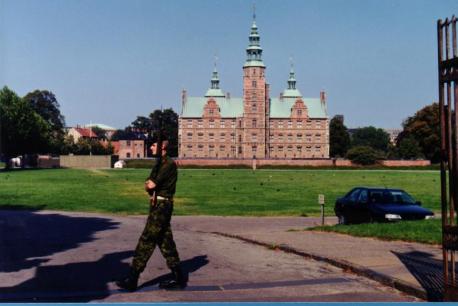

The Danish military is also part of the United Nations’ peacekeeping forces throughout the world. The Danish military is divided
into an Army of up to 45,000 people, a Navy of 7,300 people, an Air Force of 11,000 people and a Home Guard of 60,000 people.
The Minister of Justice is the official director for the
Danish police system, which is divided into 54 districts plus Greenland and the Faeroe Islands. The police is also divided into areas of specialty under a National Police
Commissioner. These areas are the Serious Crimes Squad, Forensic Technical Support (mostly scientists and technicians), The Dog Section, Traffic Patrol, and the
Special Operations and Response Team.
In actuality, the police has three separate parts that are supervised at the local level by a chief plus the lawyers who prosecute
criminals in the courts.
There is the Criminal Investigation Division (CID) who are mostly detectives and scientists that solve crimes.
Most of the police force is made up of the Uniform Branch, who are the ones everyone sees patrolling in car, bicycles, horses or by foot to keep the peace. And
then there is the Police Office Section, where much of the daily paperwork at police stations is taken care of including giving citizens passports.
Among the many responsibilities of the Danish police are to secure the national borders, including the airports, protecting the
lives of everyone including special units that guard government officials and the royalty, and the investigation of drug and money crimes.
Queen Margrethe II welcomes all who come to Denmark with this motto: “
With God’s help, the people’s love, and Denmark’s Strength.”
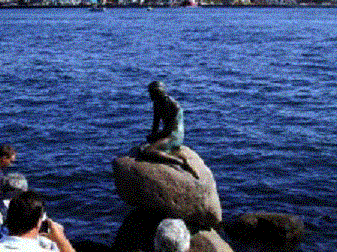
The Little Mermaid, one of Denmark’s most famous symbols from a Hans Christian Andersen fairy tale.